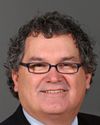That's an interesting comment. I don't disagree that it's a complex system and that we need to look at the big picture. My only concern is that what we may be looking at--because we can do something about it--is not necessarily going to be the solution. We might be able to eliminate salmon farming because we can do something about that and we don't know how to deal with global warming, but is that ultimately going to give us the results we need? What's the loss in terms of other benefits, in terms of providing seafood and providing jobs? What's the loss to Canada?
I don't disagree that it needs to be looked at in the full context, but just because we can do something about salmon farming shouldn't be the reason that we take that kind of action.




